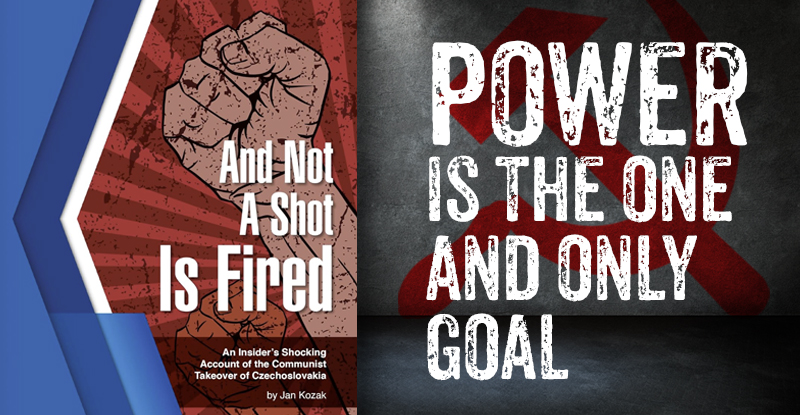This book was recommended by one of our STARRS volunteers. From the description of the book:
“And Not a Shot Is Fired is a description of how the communists took over Czechoslovakia after World War II in a non-violent, legal way.
Too many people think that a communist revolution is always a violent one.
In more countries than not, it is done through the legal process due to the ignorance of the people, who do not realize what is happening to them until it is too late.
Those who do realize what is happening usually do not form effective opposition to stop it. The communists are always organized, but their opposition is not.
Czechoslovakia is not the only example of a dictatorship coming to power through the legislative process — it happened in Italy under Mussolini and Germany under Hitler.
It can happen here if Americans do not wake up to what is going on and join in effective organization to stop it.”
Here is the book or you can buy it on Amazon:
Introduction by Robert Welch to this book:
ONE MIGHT ask today, years after the fall of the Berlin Wall: “Why would anyone want to read a report by a communist about the revolutionary takeover of Czechoslovakia — a country that no longer exists? The Czechs are capitalist-now, remember?”
Such a question reveals a number of erroneous assumptions that this document convincingly refutes — not the least of which is the false assumption that the leaders of the former Communist states of Eastern Europe were wedded to ideology.
As Jan Kozak and 40 years of brutal Communist Party rule in Czechoslovakia so clearly demonstrate, communism was a tactic employed for the assumption of power, rather than a sincere belief.
These same tactics, modified only slightly, are being used today.
Americans who labor under the false premise that communism is either an ideology or a system of economics that died with the Cold War do so at their personal and national peril.
Most Americans are falsely conditioned to believe today that elective governments are permanently established and practically invincible to destruction, so long as elections are free from fraud and consumers can buy Big Mac hamburgers in the market.
And Not a Shot Is Fired authoritatively disproves that myth.
This document is a “how-to” manual for totalitarian takeover of an elected parliamentary system of government through mainly legal and constitutional means.
Kozak did not pontificate fuzzy theories of how “revolutionary parliamentarianism” might be accomplished. He wrote from personal experience and intimate knowledge of how this seizure of power actually was accomplished.
Kozak’s manual is especially important for contemporary Americans because most of the same methods described in this book are at work in the United States today, although those methods are not being followed directly under communist ideological auspices.
And Not A Shot Is Fired only accidentally made it into the public domain. Written between 1950 and 1955 (and revised somewhat after that) as an internal Czechoslovak Communist Party strategy paper, the two chapters which comprise this document were discussed briefly by Communist Czechoslovak delegates to the Inter-Parliamentary Union (IPU) in London in the fall of 1957.
Kozak was a member of the Czechoslovak Communist Party Central Committee. briefly a member of the government secretariat, and later, official historian for the Czechoslovak Communist Party. . . . .
. . . . The value of this book is not that it explained “new” techniques or strategies for taking over free governments. There was nothing original in the strategies and tactics for taking over free governments outlined by Kozak, although many Americans in the 1960s — even among those who thought they were well informed — regarded Kozak’s blueprint as new tactics and ideology.
In fact, most of what Kozak describes had been theorized a generation earlier by Italian Communist Party chief Antonio Gramsci.
But only Kozak has demonstrated how such a takeover actually was accomplished. And Not A Shot Is Fired has enduring value for several reasons, not the least of which is that the brief treatise is sufficiently straightforward — and comparatively free of communistic dialectical jargon — that it can be profitably read by the casual reader.
That the document was written in a form readily comprehensible by the lay reader can only be chalked up to Communist overconfidence in the inevitable ascendancy of their empire.
Kozak boasted that the Communist empire “comprises over 25 per cent of the whole world; 35 per cent of the world’s population lives in it and about 30 per cent of the world’s industrial output is produced by it.” (Page 1)
To be sure, Jan Kozak prolifically used communistic patois throughout the manual, drawing from a lexicon that has been alternatively termed “dialectics,” “wordsmanship,” and “Aesopean language.” And the document can be read much more profitably with a thorough knowledge of the Communist Party’s dialectic of that time frame.
But Kozak’s manuscript is one of those rare specimens of totalitarian literature where the main thrust of the document is understandable on its face even without that knowledge.
Ideology as a Tactic, Not a Belief
The one, overriding goal stressed by Kozak was the objective of seizing total power. There is no concern for the lot of the poor, or the conditions of the laborer, or even the wealth of the industrialist evident in this manuscript: power is the one and only goal:
The overall character of the participation in this government was: not to lose sight, even for a moment, the carrying out of a complete socialist coup. (Page 12)
By using these methods, this principle was fulfilled in practice: not to lose sight for a single moment of the aim of a complete socialist overthrow. (Page 18)
[T]he following may and must be carried out successfully … concentration of all power in the hands of the [communist-dominated] parliament.” (Page 38)
In the course of the fight for the complete takeover of all power… (Page 39)
Its [the Communist Party’s] aim was … the definite settlement of the question of power by consolidating people’s democracy into a state of the dictatorship of the proletariat. (Page 46)
There are more passages in the book about how the leaders of the Czechoslovak Communist Party sought dictatorial power for themselves, but the murderous 40-year reign of this criminal syndicate (a criminal syndicate clothed with the pretended legitimacy of state power) makes further elucidation unnecessary.
Kozak was no dreamy- eyed professor embracing a nebulous idea of a future socialist utopia; he and his confederates were reality-hardened schemers who would use any method available to gain as much power as possible.
To power-hungry conspirators like Kozak, Communist ideology was mainly a useful cover for the organizational undertaking of a coup d’etat a tactic, not a belief system.
The Communists actually disdained other socialists, such as social democrats, even though they constantly strove to coalesce with and co-opt these democratic parties. . . . (read the rest)









Leave a Comment